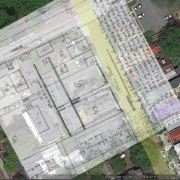HFFI’s 2024 Preservation Award Recipients
/0 Comments/in Uncategorized /by HFFI StaffThe Historic Fredericksburg Foundation, Inc., held its 69th Annual Membership Meeting on Saturday, March 9, recognizing people, businesses, and institutions that have made outstanding contributions to preserving the unique cultural heritage and historic built environment of the Fredericksburg area.
Five recipients of HFFI’s 2024 Preservation Awards were individuals. The first, retired Spotsylvania middle school teacher Mayo Carter, was honored with the Lillian D. Reed Volunteer Award for her support of local history education and efforts to connect the public to the past at HFFI events and throughout the community. This award, given to a dedicated volunteer, is named for one of HFFI’s founders. Lillian Dooley Reed (1903–1998) was an outstanding area preservationist who championed HFFI’s earliest efforts to save and relocate the two-story brick dependency from behind the National Bank, now home to Foode restaurant.
Linda Billard received the President’s Exceptional Service Award this year in recognition of her unflagging support and invaluable editing and writing skills for HFFI’s publications for many years. Ms. Billard is a retired writer/editor, who has supported the production of many HFFI publications, including the 2018 book, Home for the Holidays: Historic Fredericksburg’s Candlelight Tradition.

Two individuals received the President’s Special Recognition Award. The first is historian and author, Dr. Keith Littlefield, who grew up in Fredericksburg and continues to research and publish local history. His most recent book is From New Post to Princess Anne St: The Postal History of Fredericksburg, Virginia 1657–1990. The second recipient of a Special Recognition Award is Michael Way, a project manager with Island Architects in Richmond. Mr. Way was recognized for volunteering his time and expertise to retrieve and reformat measured drawings of the Renwick Courthouse, Wallace Library, and Old Jail. This documentation has already been used to assist the ongoing structural analysis of the tower by REI Engineering and will reduce the cost of any future rehabilitation work at the complex.
The last individual honored at HFFI’s meeting was Noel G. Harrison, recipient of the Dr. Edward D. Alvey, Jr. Education Award. Named in honor of Alvey (1902–1999), a former Dean and Professor of Education at Mary Washington College and past president of HFFI, the award recognizes Harrison’s significant contributions since 1984 toward the advancement of preservation-related education. A cultural resource specialist with the National Park Service at the Fredericksburg and Spotsylvania National Military Park, and specializing since 2007 on the management of Park Service-held conservation easements, Harrison is an exemplary scholar of histories well beyond Fredericksburg and regularly shares his knowledge in regional publications. He has written definitive reference guides to local sites of historical importance to the Civil War, including Fredericksburg Civil War Sites, Volumes I & II (1995); Chancellorsville Battlefield Sites (1990); and A Walking Tour of Civil War Sites on the Campus of Mary Washington College (1993). Harrison was also a regular contributor to the National Park Service’s website, Mysteries & Conundrums: Exploring the Civil War-Era Landscape in the Fredericksburg & Spotsylvania Region and has written articles for HFFI publications. Fellow cultural resource specialist at the National Park Service Eric Mink presented the award on behalf of HFFI, and many local researchers posed for a group photograph to show their appreciation.
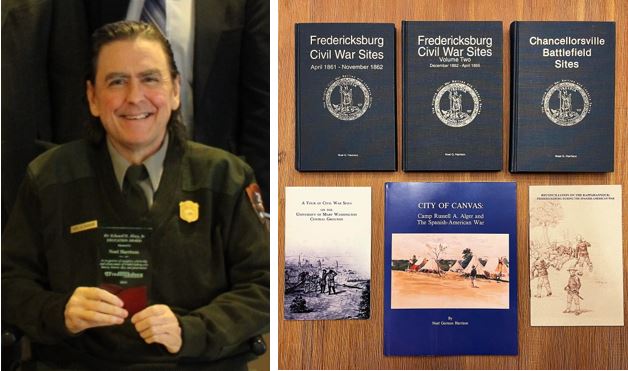
The final two HFFI awards recognized the act of preservation through the rehabilitation of historically significant resources in the Fredericksburg. One project was spearheaded by the University of Mary Washington and the other by the Virginia Railway Express.
In the UMW project, the university undertook a historically sensitive rehabilitation project to adaptively reuse the 1931 Seacobeck Hall designed by architect Charles Robinson. The project converted the former dining hall into a mix of “classrooms and lab space with the latest technologies, faculty offices, collaboration and group work rooms, student organization spaces, a large assembly space, a curriculum lab, and makerspace,” according to architects at the Richmond firm Hanbury. Members of Hanbury’s design team and the Whiting-Turner Contracting Company joined Capital Outlay Director, Gary Hobson, of UMW in accepting HFFI’s E. Boyd Graves Preservation Award, presented by Professor Michael Spencer, author of UMW’s Campus Preservation Plan and acting Chair of the Department of Historic Preservation. The E. Boyd Graves Preservation Award is named for one of HFFI’s founding members who played an instrumental role in protecting, preserving, and adaptively reusing some of Fredericksburg’s most recognizable historic landmarks.
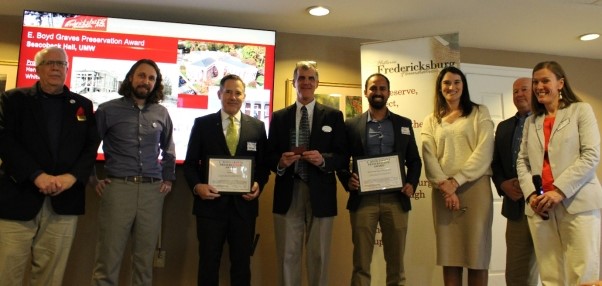
HFFI recognized another notable preservation project by the Virgina Railway Express (VRE) to preserve the Fredericksburg train station’s 1927 concrete platform and Sophia, Caroline, and Charles street overpasses. Designed by noted engineer John E. Greiner & Company in 1924, the platform and overpasses are a connected series of form-poured, reinforced-concrete structures that carry the elevated tracks through downtown. VRE’s laudable effort required skillful precision and technologically advanced techniques to properly analyze existing conditions, remove deteriorated fabric, conserve sound historic material, and make necessary repairs. Recognizing the significance of this historic transportation resource and the vital economic role it serves in our community, HFFI gave its Preservation Spark Award to VRE CEO Rich Dalton and Fredericksburg Station Project Manager Kip Foster. Fredericksburg City Council members Jannan Holmes, who represents the city on the VRE Operations Board, and William Mackintosh, Ms. Holmes’ alternate on the VRE board, were also in attendance.

HFFI’s Board of Directors is pleased to honor these exceptional individuals and organizations for their unwavering commitment to preserving Fredericksburg’s rich history, architectural legacy, and cultural landscape. Their dedication serves as inspiration to us all, reminding us of the important ways that historic preservation nurtures our collective memory and challenges us to learn from the past.
Most Affordable Housing Isn’t New
/0 Comments/in Uncategorized /by Danae PecklerWe all support increasing the supply of housing within Fredericksburg city limits. We just don’t have much of a shared understanding about what that growth will look like—what types of new housing is best suited for which locations or what kind of benefits and trade-offs are expected in those places.
Our city is not alone in grappling with the current housing crisis and this is not the first time local residents have voiced concern about rapid growth’s impact on the community; shown interest in preserving the character of their neighborhood; and struggled with the rising cost of housing.
A look back at vision statements, goals, planning documents, and action plans produced by our elected leaders and professionals on City staff over the last two decades reveals a consistent dialogue about Fredericksburg’s future with the simultaneous desire to grow AND preserve this community.
It is widely acknowledged that the most “affordable” housing units are within older, smaller buildings on smaller, narrow lots. Densely developed from the start, these spaces are essential, critical components of a city’s housing stock—yet they are also at the highest risk. The last 30 years or more across Virginia, areas with increasing development pressure saw these older resources become soft targets for neglect and demolition as profit margins from newer, bigger buildings rose.
In the last decade, several less “historic” and “attractive” houses have disappeared around town. Perhaps you have noticed one or two?
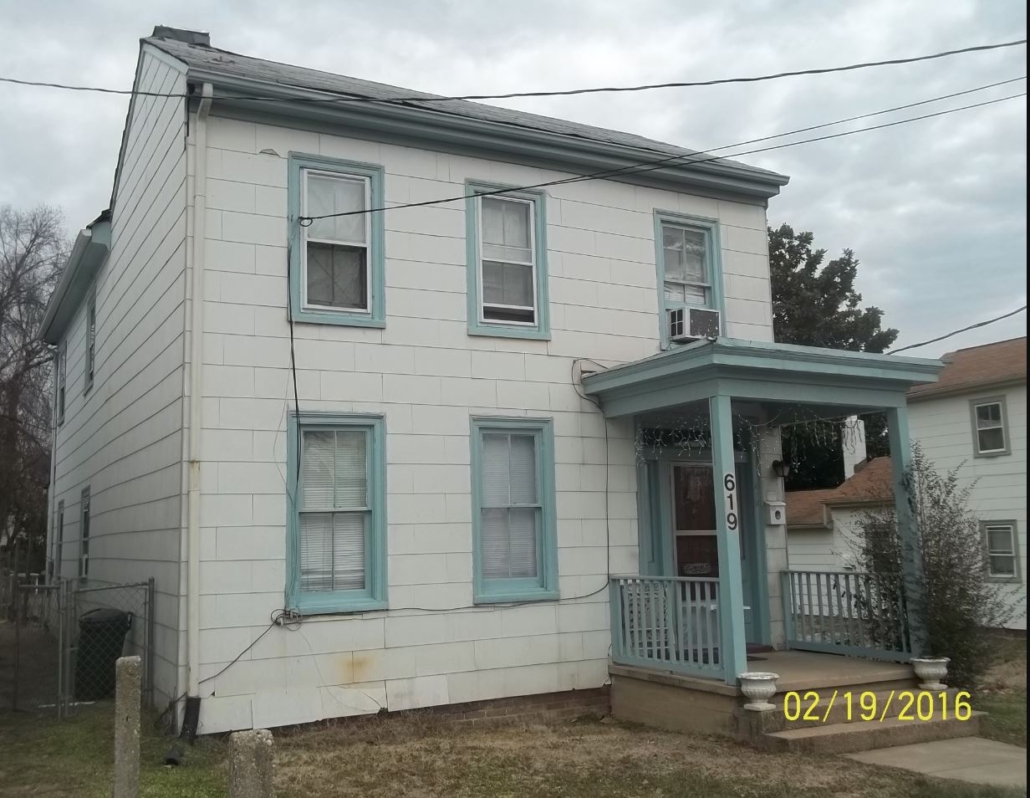
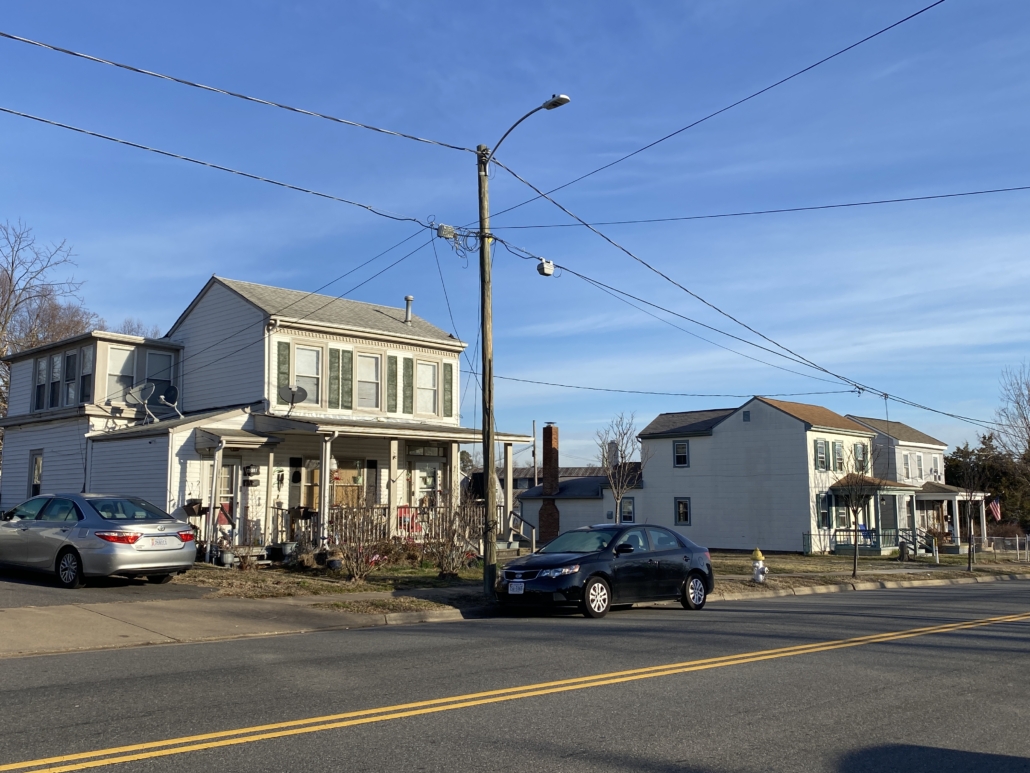
Some people say that is “the way of things”—older smaller buildings should be sacrificed for progress. Short-sighted and wasteful, this thinking has eroded the historic fabric and collective memory of many American cities.
Fredericksburg’s existing residential resources—in and out of the historic district—are the most vital and affordable components of our housing stock. What kind of support is available for individual property owners and smaller-scale real estate investors who wish to maintain and significantly rehabilitate these assets?
A June 2023 report produced by a nationally recognized expert compiled nearly a dozen ways the City of Fredericksburg could incentivize the preservation of our built environment—none of which place any restrictions on property owners or City staff.
So if we, as a locality, are going to change the rules in support of new housing construction, why hasn’t the City Council moved with equal speed to encourage and support those seeking to preserve and update our existing stock? We hope that our elected representatives will join HFFI and engage whole-heartedly in the thought-provoking dialogues occurring throughout the Preservation community, particularly at the local level. Because we can all agree that Fredericksburg should do as much as we can to promote the preservation and rehabilitation of its most affordable, most sustainable, and most culturally diverse housing type.
More About the Connections Between Preservation, Affordable Housing, & Increasing Density:
“Older, Smaller, Better: Measuring how the character of buildings and blocks influences urban vitality” National Trust for Historic Preservation Green Lab, May 2014. Analysis of data from three major American cities shows that areas with a mix of older, smaller buildings perform better than districts with larger, newer structures when tested against a range of economic, social, and environmental outcome measures.
“Affordable Housing and Historic Preservation: Opportunities in 2024.” National Trust for Historic Preservation webinar featuring expert panelists from the Advisory Council for Historic Preservation (ACHP), American Planning Association (APA), and an conservation architect working in the private sector who examine the opportunities and strategies for changing federal policy and expand the marketplace for utilizing historic and older buildings to increase the supply of housing nationwide.
“Why Housing Policy Should Include More Funding for Home Repairs” by Todd Swanstrom and John N. Robinson III – August 17, 2023 – Researchers found that older homeowners in St. Louis averaged $13,000 in unmet home repairs. Here’s how advocates can measure home repair need in their own cities, and why repairs make a difference.
“Densifying Suburbs Is the Better Path to Housing Affordability” by Alan Mallach -August 10, 2020 – Alan Mallach responds to critiques of his assessment of urban versus suburban upzoning.
Advisory Council on Historic Preservation’s Policy Statement on Housing and Historic Preservation. Finalized in December 2023, the ACHP’s “policy statement discusses the need for more incentives – including expanded rehabilitation tax credits, plus energy and housing credits that work well with rehab credits – to promote rehabilitation of historic buildings for housing and the need to remove disincentives. For instance, changes to zoning codes could encourage greater density and availability of housing, and allow for mixed uses and for creation of housing in historic buildings in areas where it is now prohibited…. [It also] supports the federal government making underutilized historic government buildings available for housing development and developing expanded guidance regarding reuse and rehabilitation of historic properties for housing…. [It further] encourages consultation and engagement with Indian Tribes, Native Hawaiian organizations, disadvantaged and underserved communities and communities with environmental justice concerns, all of which are disproportionately affected by the housing shortage. Another focus of the document is the need for research and sharing of information about the costs, benefits, incentives, and disincentives associated with rehabilitating historic buildings for housing.”
HFFI supports expert’s Preservation Recommendations and the creation of Preservation Advisory Group
/in Uncategorized /by HFFI StaffThroughout 2023, Fredericksburg city staff and Historic Resources Planner, Kate Schwartz, worked with Heritage Arts of North Carolina LLC to enhance incentives and non-regulatory tools for preservation and to update the city’s spot blight/demolition-by-neglect provisions (see Chapter 8, Goal 2). Heritage Arts is a North Carolina-based historic preservation consulting services firm owned and operated by Dan Becker.
Becker, a nationally recognized expert in the field of Preservation Planning and Policy, is familiar with Fredericksburg’s preservation and planning initiatives. In 2021, HFFI hired him to provide an independent review of the city’s updated Preservation Plan and Historic District Guidelines. At that time, Becker also reviewed the City Council’s 2036 Vision and Comprehensive Plan along with related program and budget documents to get a broader sense of the principles, goals, and activities shaping our community.
The current investigation reviewed Fredericksburg’s existing preservation economic development tools and “demolition-by-neglect” provisions and gathered input from local stakeholders through a strengths, weakness, opportunities, and threats (SWOT) analysis survey. HFFI volunteers invested many hours to complete the SWOT survey and participated in a work session, along with city planning staff and representatives from the Architectural Review Board, FXBG Main Street, and UMW’s Department of Historic Preservation, to discuss these matters.
The results of this collaborative effort are documented in Becker’s report entitled, Historic Preservation Recommendations: Economic Incentives and Spot Blight/Demolition by Neglect, presented by Historic Resources Planner, Kate Schwartz, to the public and City Council at their work session on September 12, 2023.
The report presents recommendations to strengthen local preservation tools and boost their effectiveness. However, the measures outlined in this report go far beyond preservation to support a multitude of Comprehensive Plan goals and initiatives in the sectors of business, transportation, and public services to:
- foster a more livable community;
- promote sustainability in our built environment;
- retain neighborhood character;
- strengthen business and employment opportunities; and
- enrich Fredericksburg’s cultural experience for visitors and residents alike.
One of the most important recommendations in Becker’s report calls for a citywide Historic Preservation Economic Impact Study. Local preservationists have long advocated such a study, which has been listed as a Preservation goal on the City Council’s 3-Year Priority Task List since 2021. This kind of economic assessment is long overdue for a town as historically rich as Fredericksburg! It should also study preservation’s impacts beyond the boundary of our Old and Historic District to provide insight into the beneficial ripple effects that conserving the built environment of our community has on other “quality of life” indicators such as affordability, walkability, sustainability, job production, and cultural enhancement.
HFFI fully supports the findings of this report and hopes that the Council will not shortchange this important subject. Talk to your council representatives and those running for office to raise their awareness of the value of the report’s recommendations to Fredericksburg residents! Consider asking them: “Are you familiar with the new Preservation Incentives report? What about it resonates most with you? Will you support its recommendations to strengthen FXBG’s preservation incentives and encourage investment in the repair/rehabilitation of our existing building stock?”
But wait, there’s more good news!
HFFI also fully supports city staff’s proposal to establish the Historic Preservation Advisory Group. The creation of this group is another goal from the 2021 Preservation Plan (Chapter 8, Goal 7). Its purpose is to draw from local expertise in the field to assist the city in furthering best practices and support the Council’s vision to be “a proven leader in historic preservation.” Although this group was also discussed at the September 12, 2023, work session, no written document is yet available on the city’s document center. However, the discussion during the work session indicated that the new group’s participants would include an appointed Council member and representatives from HFFI, UMW’s Preservation Department, the National Park Service, Fredericksburg Main Street, and the City’s Museum Work Group.
HFFI is ready to participate in and support this new advisory group, assist city staff and hired consultants with technical support, and to continue serve as a preservation advocate and resource for the community.
Want to learn more on this topic?
- Review Heritage Arts’ June 2023 Preservation Recommendations report (see below!)
- Existing Rehabilitation Tax Incentives available to Fredericksburg residents, businesses, and property owners
- Watch Fredericksburg City Council’s September 12, 2023 work session
- Read Adele Uphaus‘ article in The Free-Lance Star, “City Council to Explore Historic Preservation Incentives”
- Check out Heritage Arts’ 2021 Observations Letter on Historic Preservation in FXBG
Preserving the Renwick (2023 edition)
/0 Comments/in Uncategorized /by Danae PecklerHistoric Fredericksburg Foundation, Inc. is pleased to see that the City has begun discussing the future of the Renwick Complex with the public once again, and we are glad to have been asked to participate in the newly established “Renwick Working Group” charged with finding a new path forward for its future.
It’s been a couple of years since the Renwick was discussed at City Council, but it first appeared in 2023 on the January 10 work session agenda when the idea was floated to sell the entire complex to a private developer-this did not resonate well with many in attendance, according to observer accounts. The second time it came before the Council was at its March 14 regular meeting where some local leaders seemed unaware of the added benefits derived from individual listing on the National Register of Historic Places particularly state and federal grants (Cut to the Council Agenda around 39:00-59:00 to watch that March 14 discussion: https://www.regionalwebtv.com/fredcc).
The third time the subject was on the agenda was at the May 23 work session where a hired consultant, Paige Pollard of Commonwealth Preservation Group (CPG), gave a presentation that focused on finding and funding a new use for the property. City Manager, Tim Baroody, also addressed upcoming rehabilitation work to stabilize the Renwick tower–said to be completed by the end of the summer. Ms. Pollard continues to be involved with the City’s effort to plan for the Renwick’s future and has been hired to support City staff as part of the Renwick Working Group, an 11-member advisory committee created by City Council on June 13, 2023.
The Renwick complex continues to be a topic of discussion at HFFI Board meetings. Our organization sent two letters to Fredericksburg’s City Council about the courthouse in April 2023 to advocate for critical maintenance work needed to prevent its further deterioration. The first letter renewed HFFI’s 2019 offer to split the cost of preparing a National Register nomination to analyze and quantify the historic significance of our unique, one-of-a-kind, Gothic Revival courthouse. HFFI’s second letter expressed our concern for much-needed basic maintenance at the complex sevens years after a Historic Structures Report (HSR) detailed the work needed to preserve it.
We will pay a high price for this deferred maintenance, and in more ways than one. While we have watched the original cupola windows deteriorate and fall apart over the last few years, other less visible matters remain unabated, possibly worsening over time and potentially creating new problems. Ultimately, the cost of continued negligence includes 1) a loss of authenticity and material integrity of the building(s); 2) higher costs for the materials and labor needed to repair/replace damaged fabric or address bigger/new problems; and 3) a reduction in the entire complex’s property value. The immediate maintenance needs of the complex should not be deferred a moment longer.
Why does HFFI think the preparation of a nomination is worth starting ASAP? Because its national historic significance would enable greater access to federal grants like “Save America’s Treasures” that can match up to $750,000 bricks-and-mortar preservation work. And getting additional grant funding is not such a long shot! As long as the building remains publicly owned, there are many more funding sources available to assist in its careful and sensitive rehabilitation.
What about Commonwealth Preservation Group’s suggestion at the May 23, 2023 work session to hold off on preparing a nomination until the new use has been selected? This is a fine suggestion but is geared more toward planning for the use of historic tax credits by a public-private group or private entity for rehabilitation than anything else. While it’s fine to wait for complete answers to the future use of all three buildings, it’s also fine to update an existing National Register nomination. The Courthouse’s “national level” of significance is all about its original architecture and design. Thus, the period of time that supports its national-level significance (a.k.a. “period of significance”) will not change. We know it will extend from 1849 until 1852 when James Renwick, Jr. was creating and shaping the courthouse complex. Obtaining official recognition of its national significance could take 6 months to a year. Add a little more time to apply for state and federal grants, and you can see why HFFI is anxious to finish what we advocated for back in 2019 and got started for the City in 2020 when we submitted the preliminary paperwork to the State Historic Preservation Office, the Virginia Department of Historic Resources (DHR).
What other sources of revenue are available other than historic tax credits? Historic tax credits (HTCs) are the most-popular financial incentives in the repair and rehabilitation of National Register-listed properties, yet this beneficial tool is designated and reserved for taxable entities. And Virginia supports the owners of historic commercial and residential buildings with one of the highest credits in the country! Non-profit organizations and localities can play a strong role in HTC projects, but non-taxable entities are not typically in the driver’s seat.
Sale or Lease: Another source of immediate revenue could be derived from the sale or long-term lease of any portion of the property. The market value of the Wallace Library alone has been estimated at around $1 million, but a long-term lease of the library or any building in the complex could generate consistent revenue to offset the cost of its preservation.
Grants: Additional sources of revenue are available to support the preservation of historic resources in Virginia, many of which can be applied to publicly-owned buildings like courthouses. The DHR’s Financial Incentives Guide “is a comprehensive listing of major sources of funding and tax incentives that Virginia’s citizens and local governments can use to preserve and capitalize upon historic sites. Whether you are a private homeowner, commercial investor, developer, planner, mortgage lender, banker, or real estate agent, this guide will prove a valuable resource to identifying current financial tools and incentives for rehabilitating historic buildings, districts, and cultural landscapes.” Other grants for preservation are available from national sources, like the Save America’s Treasures program. Once the Renwick Courthouse’s national level of significance is proven through an individual National Register nomination and subsequent listing, more doors to support the future preservation of the property will be opened.
Want to learn more about the Renwick Working Group and what’s being discussed about the future of the complex? HFFI will continue to provide regular updates to our members as this critical moment in our town’s preservation history unfurls, but members of the public are welcome to attend any of the Renwick Working Group meetings. The first meeting took place on July 13, 2023, and outlined the charges set forth for the committee by City Council. Further discussion was held this past Thursday (August 24th) at the group’s second meeting of the group.
Stay tuned as HFFI continues to provide updates and share news on this important topic in local preservation! The public is also welcome to attend upcoming Renwick group meetings – scheduled for September 28th, October 26th, and November 16th. Check the City’s calendar and agenda center to find the latest information and further details!
A Closer Examination of Historical Significance: The Charles Dick House and J.W. Masters’ Domestic Outbuilding at 204 Lewis Street
/0 Comments/in Uncategorized /by HFFI StaffHistoric Bricks and Mortar
/0 Comments/in Historic Buildings, Local History, Uncategorized /by HFFI Staffby Natalie Chavez and Danae Peckler; edited by Linda Billard
The Lewis Store, HFFI’s headquarters, is the embodiment of honest brick construction in a classic Georgian architectural style from the mid-eighteenth century. This mass masonry brick building has multiple wythes, or vertical sections of brick wall, laid in two different bonds. The Lewis Store’s elevation showcases the stylish Flemish bond, while the interior wall of the building showcases the stronger English bond. Most of the building’s brick dates from its original construction in 1749 and added second story in 1808, although some minor repairs were made to damaged areas during its rehabilitation in 1999 and 2006. Contributing to the Lewis Store’s durability is the craftsmanship and skills of its builders and the make-up of its mortar.

Figure 1: Brick Bonds from Encyclopaedia Britannica, 11th Edition, Volume 4, Part 3, 1911.[1]
All mortars are composed of three main ingredients: a binder or cementing material, an aggregate such as sand, and water. Prior to the late nineteenth century, lime was used as the binding agent. It was created by crushing stone or oyster shells and burning the resulting material to create quick lime that was later mixed with water and sand. Traditional lime mortars are remarkably forgiving of both the weathering of time and the environment, allowing for “some movement in the brickwork without showing signs of cracking under normal seasonal conditions.”[2] This differs greatly from the rigidity of Portland cement, which became commonplace by the early-20th century. Owners of historic brick buildings make a crucial mistake by repairing mortar joints using a Portland-based mortar. While Portland cement has many benefits, its use in historic masonry creates long-term problems, even inducing decay of the bricks themselves.

Figure 2: Image from Colonial Williamsburg Showing Oyster Shells After Burning.[3]
Experts in the field of preservation advocate for using the gentlest techniques in the maintenance of historic brick. Such work is only needed every 100–150 years and, in most cases, a sensitive repointing with lime mortar will last another 100 years unless the repair is addressing the symptom of a larger problem that has gone unaddressed.
You can find more information about taking care of historic brick buildings on HFFI’s website and review Cristine Lynch’s 2012 National Register of Historic Places nomination for the Lewis Store to learn more about our great building!
Other great resources
Traditional brick construction: https://www.buildingconservation.com/articles/traditional-brickwork/traditional-brickwork.htm
Efflorescence https://johnspeweik.com/2011/11/17/efflorescence-of-masonry/
How to identify lime mortar: https://www.youtube.com/watch?v=Fh0Ad3FKDrE
Importance of lime mortar: https://www.ncptt.nps.gov/blog/podcast-episode-33-andy-degruchy-on-the-historic-uses-of-lime-mortar-and-its-continuing-importance-today/
Finding the right
mason for the job: https://www.youtube.com/watch?v=5TmW8ZvsBUs
[1] The Project Gutenberg EBook of Encyclopaedia Britannica, 11th Edition,Volume 4, Part 3. http://www.gutenberg.org/files/19699/19699-h/19699-h
[2] Geoff Maybank, “Traditional Brickwork.” https://www.buildingconservation.com/articles/traditional-brickwork/traditional-brickwork.htm
[3] Image from Colonial Williamsburg’s Richard Charlton’s Coffeehouse blog: https://research.history.org/Coffeehouse/Blog/index.cfm/2009/3/4/Lime-Burn
Library marks Golden Anniversary
/0 Comments/in Uncategorized /by HFFI StaffWritten by Nancy Moore
Fifty years ago this month, the Central Rappahannock Regional Library was launched as a demonstration library serving Fredericksburg and surrounding counties.
Trustees of Fredericksburg’s Wallace Library, established in 1908, realized that the small city library could not adequately serve the area’s growing population. The Wallace trustees considered building a new library on Washington Avenue but instead chose the vacant Lafayette Elementary School building at 1201 Caroline Street.
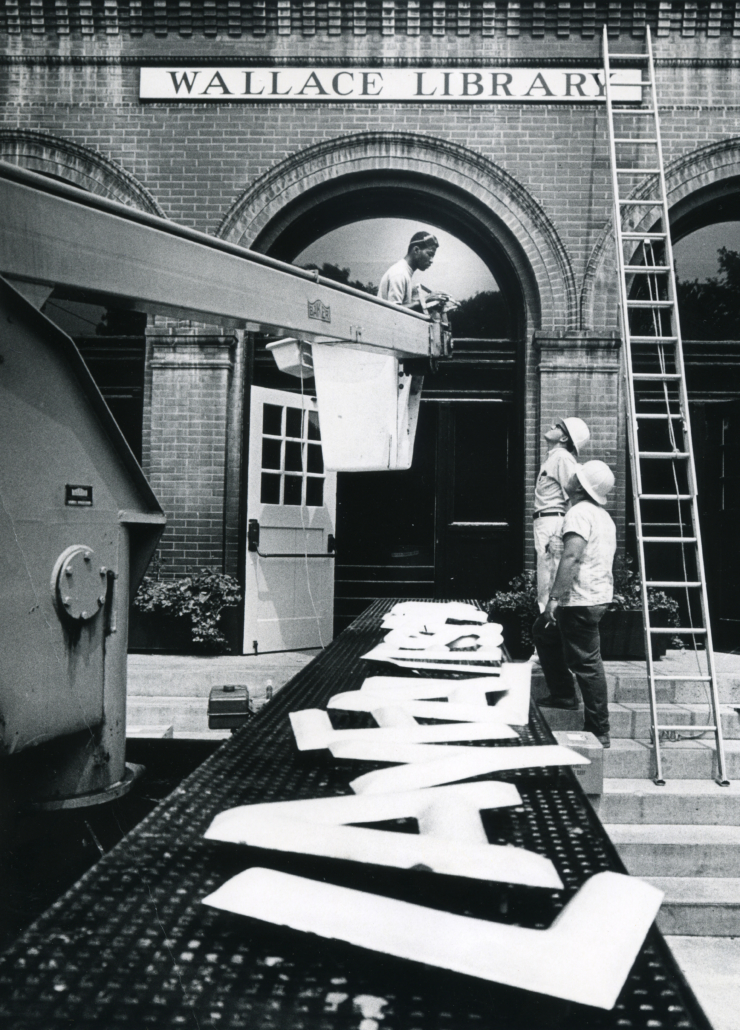
The new library—the proud offspring of Fredericksburg’s Wallace Library—was dedicated on July 18, 1969. “I predict you will wonder from this day forward how you ever got along without the services we are starting here today,” said State Librarian Randolph Church—a prophecy that has certainly come true, as the regional system continues to grow and add services.
In 1969, however, the regional system had only the Fredericksburg library to serve customers in the member counties. To fill the gap, bookmobiles took the library on the road to even the most rural communities.

It was not long before branch libraries started to spring up—1972 in Colonial Beach (now Cooper), 1978 in North Stafford (Porter), 1981 in Montross, 1983 in Spotsylvania (Snow), 1985 in Hague (Newton), 1994 in Spotsylvania (Salem Church), 2010 in Stafford (England Run—now Howell), and 2018 in Spotsylvania (Towne Centre) and Stafford’s Fried Center. And, in the bookmobile tradition, satellite locations now reside in rural Spotsylvania at the Belmont Community Center and Partlow Ruritan Club.
For many years, Fredericksburg’s Headquarters Library was the center of activities. In 2001, it became the site of the system’s first computer lab, thanks to a grant from the Bill and Melinda Gates Foundation. The Friends of the Library inaugurated annual book sales that were initially held outdoors in a paved area in front of the Caroline Street building. The popular summer Music on the Steps program is still funded by the Friends of the Library with book sale proceeds.
The Virginiana Room has always been an asset for the library system. Virginiana materials were one of the strengths of the Wallace Library, and the collection has greatly expanded over the years. Now housed in expanded quarters on the ground floor of Fredericksburg Branch, the Virginiana Room draws researchers from near and far. It has microfilm of Fredericksburg newspapers back to 1788, and a complete index of obituaries from those papers, not to mention books, maps, and city directories.
The room is an important stop for members of the Historic Fredericksburg Foundation’s Marker Committee as they study the history of Fredericksburg homes and use the newspaper microfilm collection to tell the story of the people who lived there. Copies of the completed Marker reports are available in the Virginiana Room.
Reflecting on the library’s continued growth, Library Director Martha Hutzel said, “For 50 years, Central Rappahannock Regional Library has served the community’s education, information, and technology access needs. We have enjoyed incredible community support from our localities, and we are planning for the future of library service as we strive to meet our goal of lifelong learning for everyone in our community.”
Nancy Moore is on the board of Historic Fredericksburg Foundation Inc. and serves as Virginiana Manager at the Central Rappahannock Regional Library.
“The Falmouth Canal and Its Mills”
/0 Comments/in Uncategorized /by HFFI Staff“The Falmouth Canal and Its Mills”
“The Falmouth Canal and Its Mills: An Industrial History” is an article by John Janney Johnson that can be found in the second volume of the Journal of Fredericksburg History. It focuses on the seemingly forgotten industrial past of Fredericksburg and Falmouth, Virginia. Here is a summary of that article done by Erin Adams, an HFFI intern, for your enjoyment.
The portion of the Rappahannock River between Fredericksburg and Falmouth is characterized by an extremely powerful water flow that falls 22 feet within 1 mile. This made the area an appealing site for construction of hydro-powered mills on the river’s banks. Beginning as early as the 1720s, dams were constructed so that the Rappahannock water power could be harnessed to fuel the mills that had already begun operation.
Between 1775 and 1800, the Falmouth Canal was built, prompting construction of four more mills. Between the 1720s and the 1880s, numerous mills and warehouses with varying purposes (primarily grist, flour, and iron) were constructed and operated along the canal and river bank. The passage of time, however, has eroded any trace of these once-mighty industrial structures. Upriver, the canal and its stone retaining wall are still visible, but mostly washed out or covered by greenery, and the only building ruins that remain are at the site of the Rappahannock Forge.
For approximately 160 years these mills dominated the Fredericksburg waterfront, which might seem like a fairly short time in the grand scheme of things, but they helped establish Fredericksburg and Falmouth as an industrial hub. For example, in 1816, a total of 160,000 barrels of flour were exported through the Rappahannock ports, and during the 1820s-30s, the port was widely used by western farmers in the area. However, the development of railroad technology throughout the early to mid-19th century hurt the once thriving commerce of Falmouth and Fredericksburg.
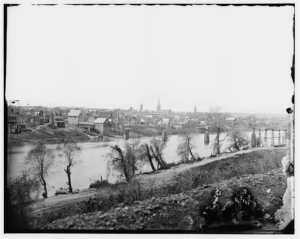
Fredericksburg, Va. View of town from east bank of the Rappahannock, Library of Congress Prints and Photographs Division
Early in the Civil War, the mills saw an increase of business (especially the steam-powered Falmouth Cotton Factory), but once Fredericksburg and Falmouth were occupied by Union troops in March 1862, all of the mills were subsequently severely damaged or destroyed. Many of the businesses attempted to reassemble their mills and continue operation, but the amount of destruction, combined with the rise of the railroad and other technologies in exportation, prevented the recovery of the mills and warehouses.
These industries faced many challenges but provided economic stability to the region before disappearing from the shores of the Rappahannock. They left minimal information behind about their impact on the community.
The full text of “The Falmouth Canal and Its Mills: an Industrial History” is a much more in-depth look into these mills and factories, their purposes and impacts, and the people who owned them (who had their own personal trials and tribulations associated with their businesses). To learn more about Fredericksburg and Falmouth’s fascinating industrial mill past, please visit the HFFI and ask about the Journal of Fredericksburg History: Volume Two.
“Battle of the Silversmith House” fought in 1962
/0 Comments/in Uncategorized /by HFFI StaffWritten by Wendy Migdal, Edits by Linda Billard, HFFI Volunteers
Soon after the Revolutionary War, a small one-and-a-half story wooden house was built on Sophia Street. Its address would not become 813 until years later. It rested on a shelf of shale by the river and had two levels of basements. Other than that, it was not remarkable for its time.
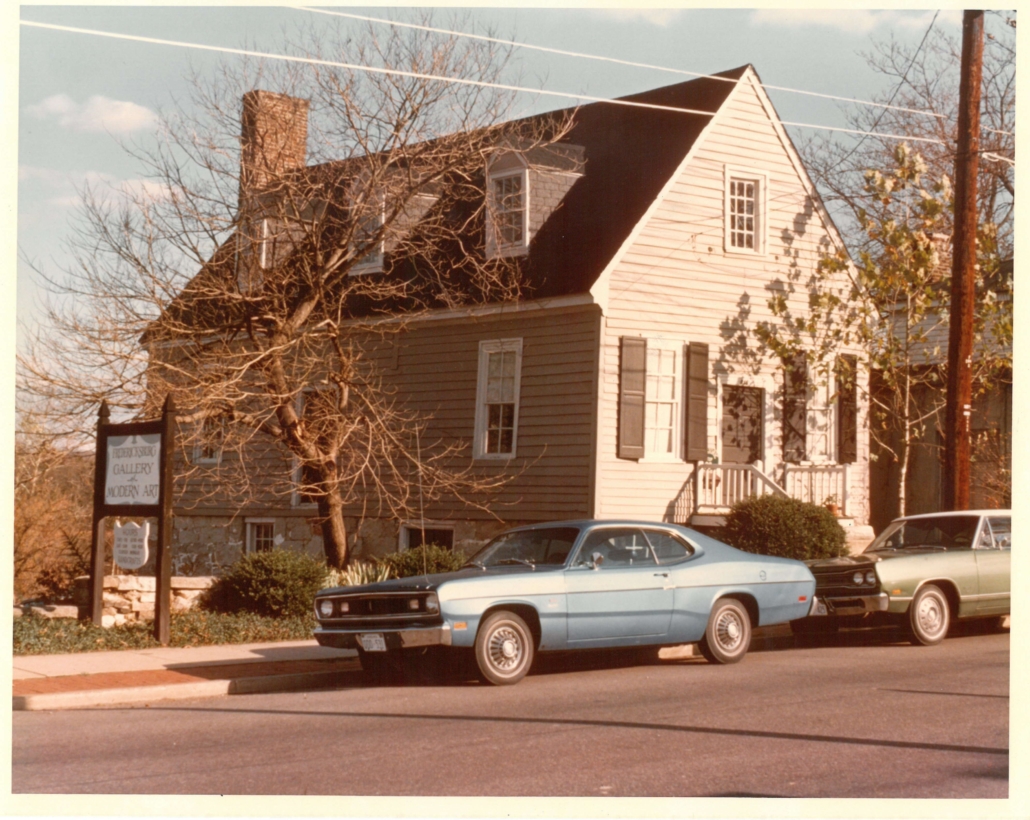
In about 1786, James Brown and his bustling family—a wife and six children—moved in. Brown was a jeweler and a silversmith, and his occupation gave the house the name it is known by today. The showroom and counting rooms were downstairs, and the family was crowded together in the half-story upstairs. Customers entered on George Street, which, at that time, continued all the way to the river.
The house passed through several generations of Brown’s descendants. The entrance was moved to Sophia Street, and interior stairs were added to reach the basement. Little else changed, even as another war came and went and shells flew overhead.
However, by 1961, this ordinary late 18th century structure had become extraordinary. Everything around it had changed. Ironically, as one of the few surviving commercial buildings in Fredericksburg from the 1700s, it was to be sacrificed for commercial interests of the 20th century. Bought by the city, it was to be replaced by that bane of our society, the parking lot. Downtown merchants, concerned about growing business on Route 1, demanded more parking.
Historic Fredericksburg, Inc. (now the Historic Fredericksburg Foundation, Inc. or HFFI) went into action, and a lengthy battle began. At first, HFFI considered a city suggestion to move the house (by now called the Cole house). This idea was rejected because it would destroy a key aspect of the house’s significance—its location. Then HFFI President Lillian Reed offered to buy it from the City Council. The town merchants resisted; they wanted their parking lot. Other options were considered, such as modernizing the building to use as a shopping destination or making it into public restrooms. Fortunately, a better solution emerged.
In February 1962, the City Council, feeling bound its promises to the merchants, ordered demolition of the house within 30 days. Offers began pouring in from people willing to dismantle the structure in exchange for the irreplaceable, hand-hewn materials. But the darkest hour is just before dawn. In April, HFFI notified the council that it had purchased another house at 1007 Sophia Street and would offer this to the city in a swap. The new location would provide 23 parking spaces versus the measly 5 offered by the Cole house.
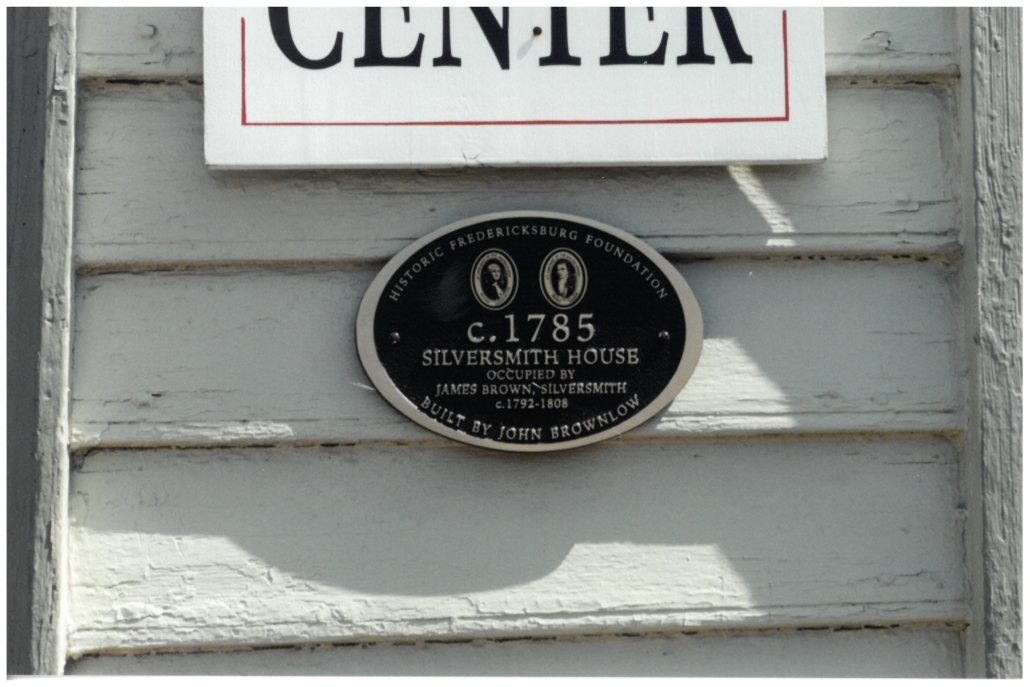
The house was saved, and HFFI won a major battle. The organization immediately leased (and later sold) the property to the Fredericksburg Gallery of Modern Art, now called the Fredericksburg Center for the Creative Arts. Just as important, that February 1962 meeting resulted in the first discussion of a proposal that eventually became the Historic District Ordinance and marked a turning point in the city’s attitude toward historic buildings.
May is National Preservation Month. Take the time to celebrate our historic buildings, visit some of your favorite locations, and support organizations that protect Fredericksburg’s historic character.
(This article can also be found in the Front Porch May 2019 edition.
https://issuu.com/frontporchfredericksburg/docs/fpfmay2019?fbclid=IwAR2bog7hJ47VA_4MMc16Jxvyrx-OFoL-fF2yv_vGA4mj2wqOvUakk6DecH4)
Contact Us
Historic Fredericksburg Foundation, Inc.
1200 Caroline Street
Fredericksburg, VA 22401
540-371-4504
[email protected]


